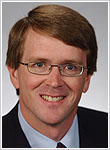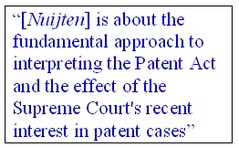 By Professor John F. Duffy, George Washington University
By Professor John F. Duffy, George Washington University
[PDF Version of this Post] In re Nuijten, which is being argued to the Federal Circuit today, presents the important issue of whether a new type of artificially constructed signal may be patented. The Patent and Trademark Office opposes patentability on the grounds that, as a matter of textual interpretation, signals do not fall within any one of the four categories of patentable subject matter - "process, machine, manufacture, or composition of matter" - identified in section 101 of the Patent Act. PTO Br. at 12 (quoting 35 U.S.C. § 101). Though Nuijten raises important issues concerning the scope of patentable subject matter under U.S. law (and that's reason enough for most patent practitioners and scholars to care about its outcome), the case is also about much more. It is about the fundamental approach to interpreting the Patent Act and the effect of the Supreme Court's recent interest in patent cases. To appreciate those larger issues, we must begin with a basic understanding of the facts at issue.
 Modern signals (e.g., for carrying audio, video or data) may be constructed to contain embedded "supplemental data" or "watermarks," which typically contain information such as the source or copyright status of the underlying information being transmitted. The addition of such watermarks, which is old in the art, can distort the underlying signal. Nuijten invented a new way to add watermarks that results in less distortion. Nuijten filed a patent application with claims directed to (1) the new process for adding watermarks, (2) storage media containing signals encoded by the new process, and (3) the signals themselves. The PTO has allowed claims for the process and for the storage media containing the signals, but not for the signals themselves. The PTO does not disputed that the signals sought to be patented are demonstrably new and nonobvious. The agency's sole objection rest on section 101 of the Patent Act.
Modern signals (e.g., for carrying audio, video or data) may be constructed to contain embedded "supplemental data" or "watermarks," which typically contain information such as the source or copyright status of the underlying information being transmitted. The addition of such watermarks, which is old in the art, can distort the underlying signal. Nuijten invented a new way to add watermarks that results in less distortion. Nuijten filed a patent application with claims directed to (1) the new process for adding watermarks, (2) storage media containing signals encoded by the new process, and (3) the signals themselves. The PTO has allowed claims for the process and for the storage media containing the signals, but not for the signals themselves. The PTO does not disputed that the signals sought to be patented are demonstrably new and nonobvious. The agency's sole objection rest on section 101 of the Patent Act.
To continue reading, become a Patently-O member. Already a member? Simply log in to access the full post.